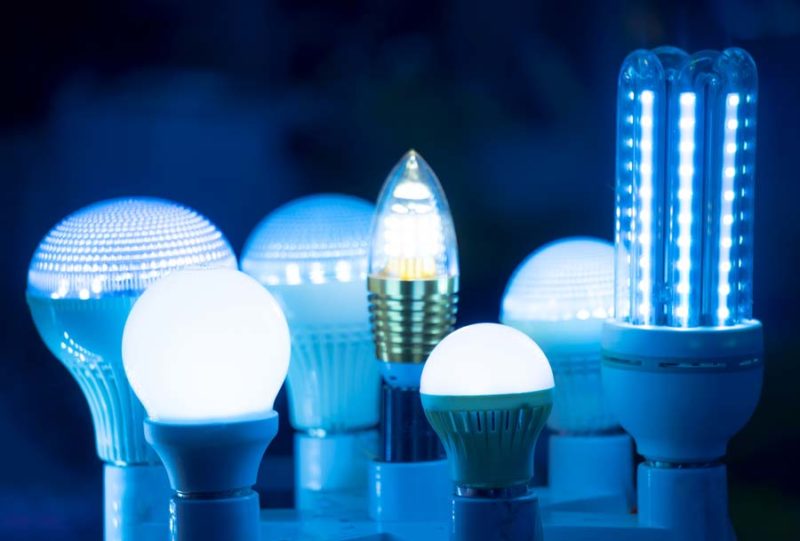Parameters and characteristics of LED bulbs
LED lamps are rapidly gaining popularity in recent years. This is due to their cost-effectiveness and improved manufacturing method. Statistics show that this light source works 20 times longer than other analogs. To buy quality LED products, it is worth knowing the parameters of LED lamps: power, size, color temperature, angle of dispersion and lifetime.
Power
Power consumption of the lighting element - one of the main factors affecting the energy consumption of the device for 1 hour. Optimal values of 6-13 watts correspond to 50-100 watts of incandescent bulbs. Total power consumption also takes into account the power of drivers that work together with LEDs. They consume about 10-15% of the total power of the device.

Type of socket
You need to know the size of the base before buying to ensure that the bulb fits into the socket in the lamp. The most common LED light bulbs with a threaded socket E14 and E27. They are considered standard and are used in wall and ceiling lighting elements. Lamps with other base threads are also available for sale:
- Е40. It is installed in lighting elements with high power. For example, in lamps for street lighting.
- G4, GU10. Plugs in LED equipment, fully replacing halogen lamps.
- GX53. This type of socket is found in recessed luminaires that are installed on the ceiling/wall.
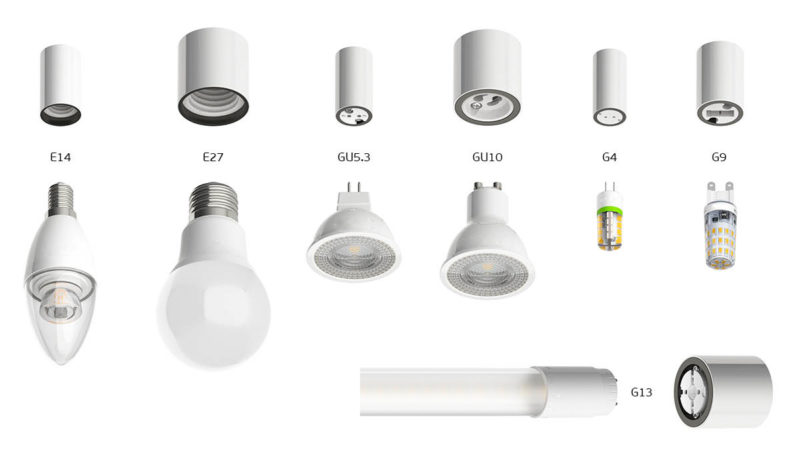
LED lighting elements are available with a G13 base, which is used in tubular luminaires.
Dimensions of LED lamps
The size of LED lamps depends on their shape.
- Form A. This category includes household lighting equipment. The standard diameter of products is 60 mm. Lamps can have a diameter of 50 to 65 mm.
- Form B. Luminaires with a more elongated body. More often used to create decorative lighting. The standard size is 55-60 mm.
- Form C. Inserted in wall lights and chandeliers. They have an elongated shape with a pointed end. The lamps use the E14 base thread. Standard diameter is 37 mm.
- CA shape. Devices with a warm light that resembles the lighting from a candle. The standard size is 35-37 mm.
- G shape. Decorative LED lighting elements with a spherical shape. Have E14 or E27 socket. Different sizes: lamps with a diameter of 30 mm for decorative lighting, with a diameter of 100 m high power. The standard diameter is 45 mm.
- T shape. LED tubes, used for commercial lighting. Standard diameter - 28 mm. Length - 60-120 mm.
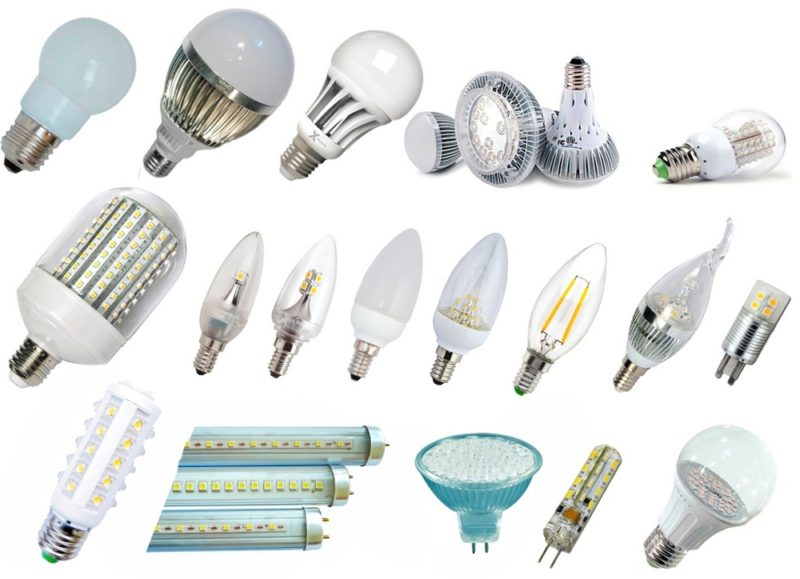
In stores there are LED lamps of different diameters: from 30 mm to 120 mm. The choice depends on the purpose and place of installation.
Weight of the LED lamp
Unlike standard lamps, LED lamp has additional elements - drivers and other additions that increase the weight. Therefore, when choosing a light source, you need to consider the weight of the LED design, so as not to weigh down the body of lamps and chandeliers, in which it will be installed. Heavy weight has advantages - reliability, increased durability, long service life.
Luminous flux
Light flux refers to the amount of energy that the lighting element gives off. Knowing the parameter, you can quickly find a replacement for a blown bulb in the lighting equipment. Light output is measured in lumens. The second parameter is efficiency. It defines the ratio of luminous flux to power consumption. These indicators indicate the cost-effectiveness of LED devices. For example, a standard incandescent bulb has a power of 20 watts. Its luminous flux is equated to 250 lumens. The same indicators of luminous flux are observed for LED bulbs with a power of 2-3 W.

Angle of dispersion
The angle of dispersion of LED devices is the angle at which the flow of light diverges from the light source. The values are measured in degrees. Values range from 15-360 degrees. Conventional incandescent bulbs have a standard angle of dispersion of 360 degrees, LED-devices - more advanced features. According to the angle of dispersion they can be divided into three groups:
- Narrow angle (up to 60 degrees). Light elements with such indicators give concentrated illumination of objects and are used for local illumination. For example, to illuminate a specific area in the house (mirrors, shelves, TVs).
- Wide angle (90-360 degrees). LED devices with such indicators create uniform lighting over the entire area of the room.
There is an intermediate option - lighting equipment with an angle of dispersion of 60-90 degrees. These are standard lamps that can be used both for local lighting and for general lighting.
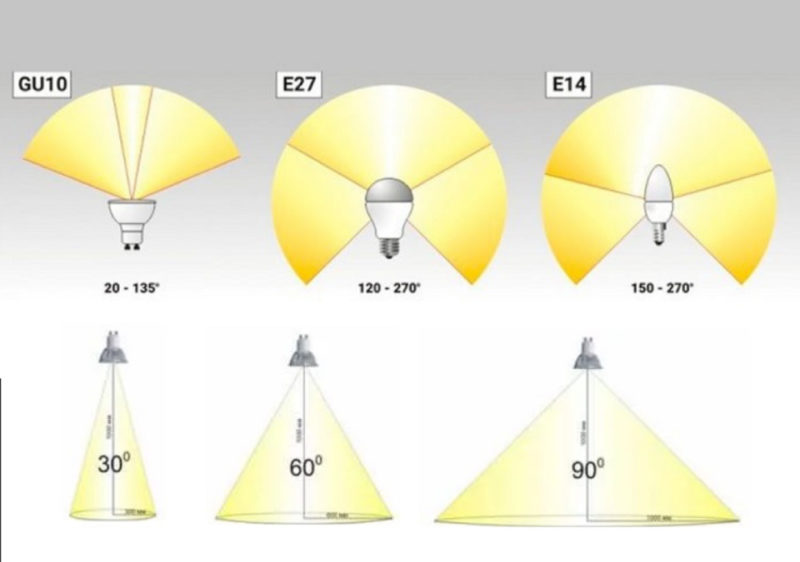
When buying luminaires with an intermediate angle of dispersion, it is better to choose models with a swiveling option. It allows you to change the color direction. The standard value is 210 degrees. It is enough to fully illuminate residential objects. In commercial and design purposes lamps with a scattering angle of 110-120 degrees are used to illuminate small details.
Color temperature
The color temperature is an indicator that indicates the shade of the emitted light flux. Conventionally, all lamps are divided into three types:
- With a warm color temperature.
- With neutral color rendering indicators.
- With cold light.
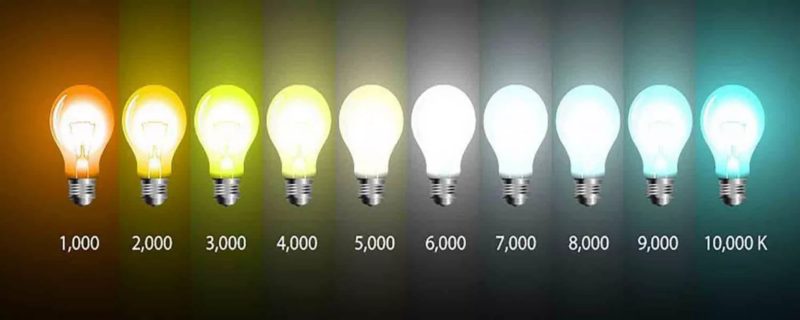
When choosing lighting fixtures, consider the place in which they will be used. If it is a bedroom, it is better to give preference to warm or white lighting (up to 3000 K). In the kitchen and bathroom, it is better to use fixtures with neutral lighting (3500 K). If you are lighting commercial facilities, it is advisable to opt for cold lighting. Equipment that creates the effect of daylight (more than 5300 K) in the living space is not used, only for specific works. Also lamps with cold light are used as elements for emergency lighting. Comparative table:
| Parameters of LED lamps, type of lighting, atmosphere created in the room | |||||
| Temperature | Warm light (2700 K) | White light (3000 K) | Neutral light (3500 K) | Cold light (4100 K) | Daylight (6000 K) |
| Atmosphere | A warm and welcoming atmosphere | Brighter light that creates a pleasant atmosphere with excellent visibility | A pleasant atmosphere with excellent visibility | Bright and clear atmosphere | Understated colors and overly bright atmosphere |
| Where to use | Residential areas, cafes and restaurants, boutiques | Stores, offices, libraries | Offices, showrooms, supermarkets, stores | Offices, hospitals and hospitals, large supermarkets, shopping malls, school classrooms | Galleries, exhibitions, jewelry retail outlets, medical offices that are used for examinations |
Lifetime
When choosing LED-lamps, it is also worth considering their lifespan, which manufacturers indicate on the packaging. However, these figures are very relative. Even if the manufacturer indicates on the box operation of 30 thousand hours, the LED lamp can fail much earlier. The overall service life depends on other parts of the equipment. Also the quality of the assembly of the lamp, the soldering of radio elements affects this indicator. Since LED elements have a long service life, no manufacturer can test the operating time. Therefore, all indications on the packages can be considered conditional.

Adjustable LED bulbs
LED devices allow you to adjust the brightness of the light. This is done with the help of a dimmer. The dimmer helps to get the most suitable light, which will not strain your eyesight. Dimmer works by forming pulses. Their frequency affects the brightness of the light. Not all LED systems can be adjusted with a dimmer. Its functions can be performed by a driver, which is built into the lamps. In this case, the functionality will be somewhat limited.
If the buyer needs dimming equipment, it is worth carefully studying the packaging of the products. All manufacturers write about the possibility of regulating lighting on the boxes.
Advantages and disadvantages of LED lamps
The advantages of LED lamps include:
- Service life. Light sources work from 50,000 to 100,000 hours without interruption.
- Economical energy consumption. LEDs are considered to be lighting sources with 10 times higher efficiency than analogues.
- Temperature resistance. LED lamps are resistant to atmospheric changes, do not deteriorate with sharp temperature changes.
- Environmentally friendly. Made from safe materials, which are not harmful to health.
Disadvantages of LED-lamps:
- Cost. Lighting elements cost more than their main counterparts.
- Size. High-power lamps have large dimensions. This is not always convenient for rooms with a small area.
- LED driver. For the stable operation of the LED system, you need a special power supply, which also has a high cost.
Another disadvantage is the difficulty in replacing diodes in case they burn out. Sometimes it is impossible to do.
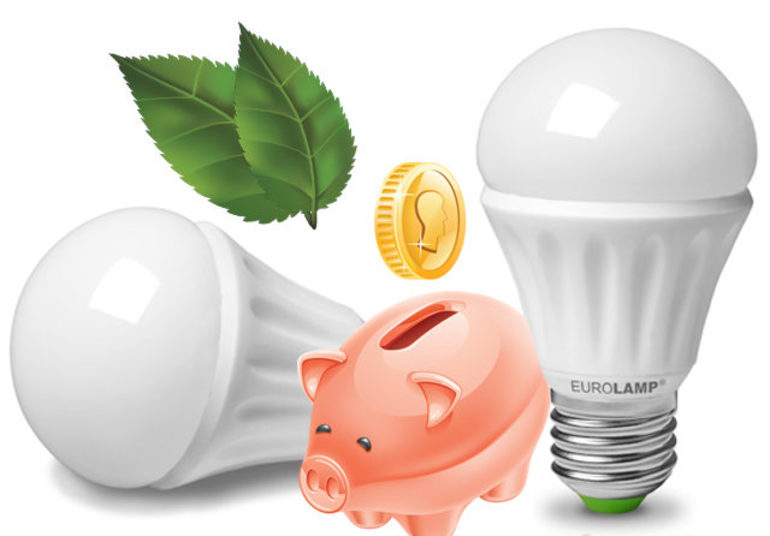
The difference between LED lights and other light sources is the transformation of light into any shade.
Conclusion
LED lights are a worthy alternative to standard incandescent bulbs. The devices work more economically, have a longer service life, and are multifunctional. Using LED devices can adjust the brightness of lighting, highlight certain objects, to create the most favorable atmosphere for the eyes in the room. On sale are different LED-lamps, which differ in shape, characteristics, size, power level, color rendering, angle of dispersion. The choice of equipment depends on the location in which it will be used, as well as the additional functions that need to perform.
